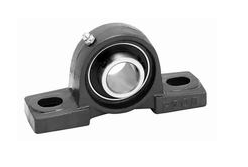Recent Posts
How to Select the Right Pillow Block Bearing
Posted by on

A pillow block bearing is a mounted bearing that is used to provide load support for a rotating shaft. Sometimes called a plummer block bearing, pillow block bearings are actually housings that have a bearing fitted into them. The mounting surface is on a plane parallel to the axis of the shaft. Mounting holes in the base allow for easy adjustment and secure mounting.
Pillow blocks often have a replaceable insert bearing. The bearing inside of a pillow block housing is normally self-aligning, but they are available in a variety of types.
Insert Bearing Types
- Plain Bearing - These are used to guide or reduce friction in linear applications. Generally they are constructed of bronze, a graphite-metal alloy, or plastic. Plain bearings use a sliding action and must be well lubricated at all times to reduce friction.
- Ball Bearings - These bearings use a ball as the rolling element allowing them to provide smooth, low friction in rotary application. Their construction includes an inner and outer rings, balls, and a ball separator.
- Roller Bearings - Roller bearings are similar to ball bearings in their use and construction, but use a roller instead of balls as the rolling element. In addition, there are 3 sub-types of roller bearings used in pillow blocks. Tapered-roller bearings use conical rollers allowing them to supports both radial and axial loads. They also carry high rolls than ball bearings. Tapered-rollers consist of an inner cone ring, an outer cup ring, a cage, and rollers. Their thrust level is about 60% of the radial capacity. Spherical roller bearings are double-row, combination radial and thrust bearings. They use a crown or spherical shape as the rolling element. Spherical bearings are the bearings of choice for high loads and loads that require tolerance to shock. The downfall to spherical roller bearings is their limited speed. Finally, there are cylindrical roller bearings which have high radial capacities and moderate thrust loads. Their crown or end--relieved shape helps reduce stress concentrations and produces low friction at greater speeds.
- Needle Roller Bearings - These use a needle roller as the rolling element. Although they are similar to cylindrical roller bearings, they have a smaller diameter to length ratio. Rolling elements are kept parallel to the shaft axis by controlling the circumferential clearance between the needles. Needle roller bearings are perfect for applications that require a low profile.
- Hydrodynamic Bearings - These bearings are fluid film bearings meaning that they rely on a film of air or oil to create an adequate clearance between the stationary and moving elements. They have a long life and maintain high stiffness, but are much more complex and expensive than other rolling element pillow block bearings.
The actual casings of pillow block bearings come in two variations. The first is the plummer block. The plummer block housing is reinforced for use in heavy duty applications like the manufacturing, mining, and construction industries. The second is split bearing housings which is completely split to the shaft. This split allows for easier inspections and bearing replacement.
Determining the correct pillow block bearing for your application, requires reviewing 5 aspects. The shaft diameter, shaft height, shaft size, maximum speed, and maximum load capacity. It's important to remember that maximum load capacity will fluctuate based on the maximum shaft speed.
For further assistance in finding the perfect pillow block bearing for your needs, contact us today. Our trained experts will go through our wide variety of products to assure you receive the best possible fit for your needs. If you make a mistake on your measuring, it's not a problem. In almost all cases, we gladly accept returns within 10 days from the order date.

